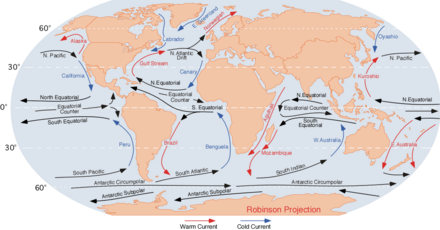This article needs additional citations for verification. (January 2014) |

An ocean current is a continuous, directed movement of seawater generated by a number of forces acting upon the water, including wind, the Coriolis effect, breaking waves, cabbeling, and temperature and salinity differences.[1] Depth contours, shoreline configurations, and interactions with other currents influence a current's direction and strength. Ocean currents move both horizontally, on scales that can span entire oceans, as well as vertically, with vertical currents (upwelling and downwelling) playing an important role in the movement of nutrients and gases, such as carbon dioxide, between the surface and the deep ocean.
Ocean currents flow for great distances and together they create the global conveyor belt, which plays a dominant role in determining the climate of many of Earth's regions. More specifically, ocean currents influence the temperature of the regions through which they travel. For example, warm currents traveling along more temperate coasts increase the temperature of the area by warming the sea breezes that blow over them. Perhaps the most striking example is the Gulf Stream, which, together with its extension the North Atlantic Drift, makes northwest Europe much more temperate for its high latitude than other areas at the same latitude. Another example is Lima, Peru, whose cooler subtropical climate contrasts with that of its surrounding tropical latitudes because of the Humboldt Current.
The largest ocean current is the Antarctic Circumpolar Current (ACC), a wind-driven current which flows clockwise uninterrupted around Antarctica. The ACC connects all the ocean basins together, and also provides a link between the atmosphere and the deep ocean due to the way water upwells and downwells on either side of it.
Ocean currents are patterns of water movement that influence climate zones and weather patterns around the world. They are primarily driven by winds and by seawater density, although many other factors influence them – including the shape and configuration of the ocean basin they flow through. The two basic types of currents – surface and deep-water currents – help define the character and flow of ocean waters across the planet.
- ^ "What is a current?". NOAA's National Ocean Service. 2009-03-01. Retrieved 2023-03-14.